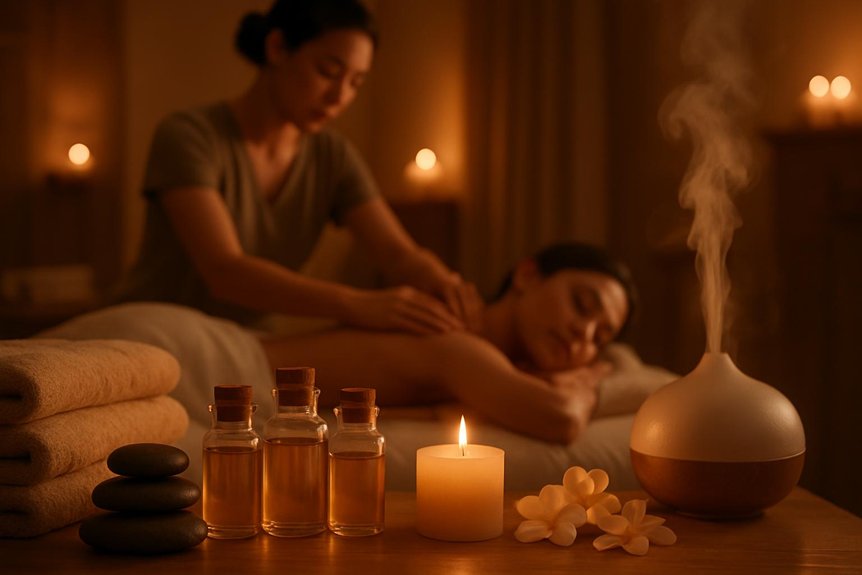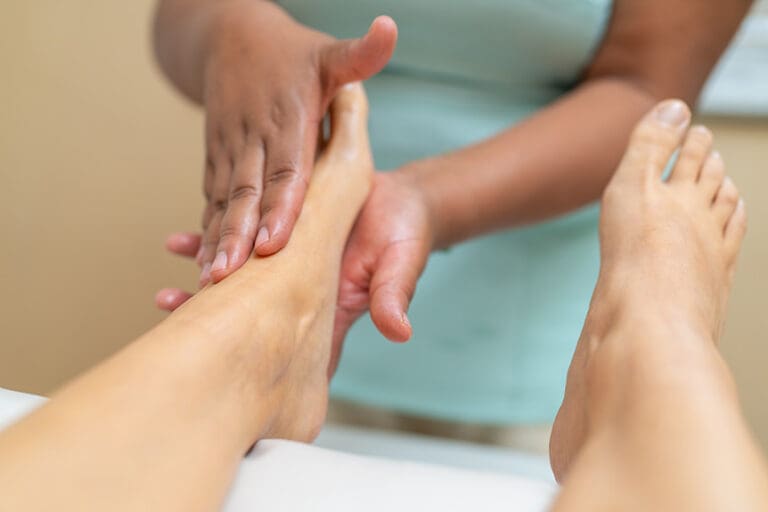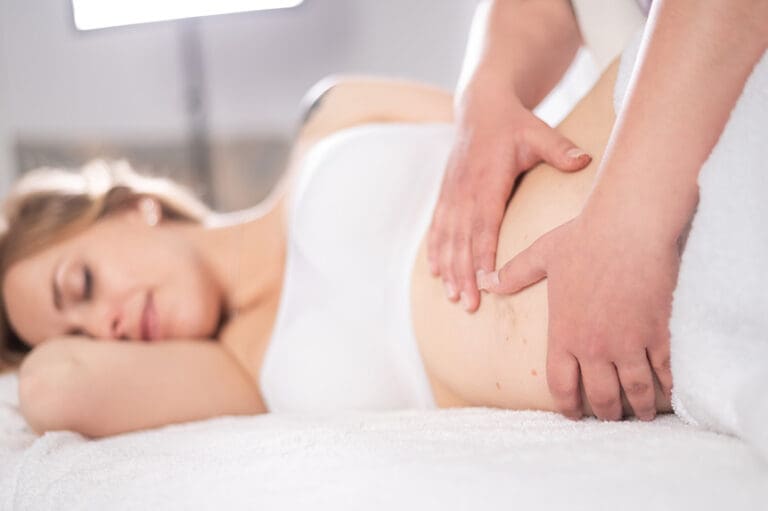Aromatherapy is a specialized form of massage that integrates the application of diluted essential oils with systematic manual techniques to achieve both physiological and psychological benefits. This practice relies on evidence-based methods, using precise essential oil blends tailored to individual needs while emphasizing safety and client comfort. It is distinguished by its focus on both olfactory and dermal absorption to modulate relaxation, stress, and well-being. Further information will clarify how this technique is personalized and its unique benefits explored.
Defining Aromatherapy and Its Principles

What exactly is aromatherapy, and how does it function within the context of professional massage therapy? Aromatherapy is the controlled therapeutic use of naturally extracted essential oils derived from plants, flowers, and herbs. In a clinical environment such as Spa & Massage, these oils are carefully selected for their documented physiological and psychological effects, including relaxation, mood enhancement, and stress reduction. During an aromatic massage, essential oils are blended with carrier oils and applied via skilled massage techniques, facilitating both transdermal absorption and olfactory stimulation. Scientific studies indicate that essential oils can modulate autonomic nervous system activity, influencing emotions and physical responses. Spa & Massage therapists emphasize strict safety protocols—ensuring purity, correct dilution, and client consultation—to create a safe, intimate, and sensorially enriching wellness experience. Another holistic approach offered in wellness settings is the healing power of reflexology, which focuses on targeted pressure techniques to promote balance and well-being in the body.
How Aromatherapy Massage Differs From Other Massage Types
While all massage modalities aim to promote relaxation and improve well-being, aromatic massage distinguishes itself by integrating the pharmacological properties of essential oils into the therapeutic process. This combination of manual manipulation and olfactory stimulation provides a multisensory experience, engaging both physiological and psychological pathways.
At Spa & Massage, therapists are trained to select suitable essential oils based on individual client profiles, ensuring both efficacy and safety.
Unlike deep tissue or sports massage, which focus primarily on musculoskeletal issues, aromatic massage utilises gentle, rhythmic strokes to facilitate absorption and inhalation of volatile compounds. This approach is particularly valued for its potential to support emotional balance and stress reduction.
Meticulous hygiene practices and client-specific oil selection are central protocols at Spa & Massage, prioritising comfort and safety throughout.
Essential Oils and Their Role in Aromatic Massage
Precisely selected for their pharmacological properties, essential oils serve as the cornerstone of aromatic massage. These volatile plant-derived compounds are chosen for their potential to modulate physiological and psychological responses through olfactory and dermal absorption pathways.
In Spa & Massage clinics, therapists employ only high-quality, pure essential oils—diluted to safe concentrations—to optimise therapeutic outcomes while minimising irritation or allergic reactions. Scientific literature indicates that certain oils, such as lavender or chamomile, may facilitate relaxation, while others, like eucalyptus, can promote mental clarity.
Each blend is tailored to the client’s preferences and needs, ensuring a deeply personalised experience. The careful application of these oils, combined with expert massage technique, fosters a multisensory environment that supports both emotional connection and physical wellbeing.
What to Expect During an Aromatic Massage Session
During an aromatic massage session at Spa & Massage, clients can expect a systematic selection of essential oils based on individual health considerations and preferences.
Therapists employ a personalised treatment protocol to optimise therapeutic outcomes while minimising potential sensitivities.
Post-session, evidence-based relaxation strategies and aftercare guidance are provided to support continued well-being and safety.
Aromatherapy Oils Selection
It integrates the therapeutic application of essential oils with targeted massage techniques to enhance physiological and psychological well-being. The process of aromatherapy oils selection is both evidence-based and safety-oriented.
At Spa & Massage, therapists employ pure, high-grade essential oils, carefully diluted in carrier oils to minimize sensitization and allergic reactions. The selection is informed by the client’s needs—such as relaxation, stress relief, or mood enhancement—while considering individual sensitivities and contraindications.
Oils like lavender, chamomile, and geranium are commonly utilized for their calming, anxiolytic properties. Therapists ensure that the olfactory profile of chosen oils aligns with the client’s preferences, fostering a sense of intimacy and comfort during the session.
This meticulous approach maximizes therapeutic benefit and safety within every therapy session experience.
Personalised Treatment Approach
While each aromatic massage session at Spa & Massage is uniquely tailored, the process consistently begins with a thorough consultation to assess client history, preferences, and potential contraindications. This evidence-based approach guarantees that essential oils and massage techniques are selected with maximum safety and efficacy.
Therapists employ a systematic method to identify any sensitivities, allergies, or medical conditions that could influence treatment. Based on this assessment, a bespoke blend of essential oils is formulated to target specific physical and emotional needs.
The massage itself incorporates both gentle and targeted pressure, facilitating absorption of the oils and enhancing physiological relaxation. Throughout the session, therapists monitor client feedback, adjusting technique and application as necessary.
This meticulous personalisation fosters a deeply nurturing, intimate therapeutic environment for each individual.
Post-Massage Relaxation Guidance
How does the body respond in the immediate aftermath of an aromatic massage?
Following the session, physiological markers such as heart rate and blood pressure often decrease, reflecting the activation of the parasympathetic nervous system.
At Spa & Massage, therapists advise clients to rest quietly for several minutes post-treatment, allowing essential oils to further absorb and the body to stabilise.
Hydration is recommended to facilitate metabolic waste elimination, as massage may increase lymphatic circulation.
Clients may notice enhanced skin hydration and subtle improvements in mood, attributed to both tactile stimulation and olfactory pathways.
To prolong benefits, Spa & Massage suggests minimising strenuous activity and avoiding hot showers immediately after.
This approach supports ongoing relaxation, *ideal* integration of aromatic compounds, and a deeper sense of well-being.
Benefits of Essential Oil Massage for Mind and Body
Why does the integration of essential oils with targeted massage techniques yield such notable results for mental and physical health? Research indicates that aromatic massage leverages both the pharmacological properties of plant-derived compounds and the physiological effects of therapeutic touch.
When applied by trained therapists at Spa & Massage, essential oils are absorbed through the skin and inhaled, engaging the limbic system and modulating neurotransmitter activity. This dual-action mechanism can reduce cortisol levels, alleviate stress, and promote parasympathetic nervous system dominance, supporting deep relaxation and emotional balance.
Physically, aromatic massage can ease muscular tension, enhance microcirculation, and support immune function. At Spa & Massage, safety protocols ensure allergen awareness and appropriate dilution of oils.
Clients frequently report enhanced mood, improved sleep, and a profound sense of connection and well-being.
Techniques Used in Aromatic Massage at Spa & Massage
The efficacy of aromatic massage at Spa & Massage is attributable to the precise integration of evidence-based manual techniques with the targeted application of essential oils.
Therapists employ a combination of effleurage, petrissage, and gentle friction, maximizing both muscular relaxation and transdermal absorption of botanical extracts. Each essential oil is carefully diluted for dermal safety and selected according to client-specific needs, supporting both physiological and emotional well-being.
The therapist’s rhythmic, attentive touch facilitates enhanced circulation and lymphatic drainage, while fostering a sense of secure intimacy.
At Spa & Massage, the sequence and pressure of each movement are systematically adjusted, ensuring clients experience the most beneficial therapeutic effect without overstimulation or adverse reactions.
This meticulous approach reflects an unwavering commitment to client safety, comfort, and holistic care.
Choosing the Right Essential Oil Massage for Your Needs
Selecting an appropriate aromatic massage involves understanding the specific physiological and psychological effects of various essential oils, as well as individual sensitivities.
At Spa & Massage, therapists develop personalised treatment plans by evaluating client health history and aligning massage techniques with desired therapeutic outcomes.
This evidence-based approach prioritises both efficacy and safety, ensuring each session targets the client’s unique wellness goals.
Understanding Essential Oil Benefits
Although personal preferences play a role in aromatic massage, understanding the specific therapeutic properties of essential oils is fundamental for achieving ideal outcomes. Scientific studies have established that certain essential oils exhibit measurable physiological and psychological effects.
For example, lavender is associated with anxiolytic and relaxing properties, while eucalyptus demonstrates decongestant and invigorating effects. In Spa & Massage clinics, therapists select oils based on evidence-based benefits, always considering individual sensitivities and contraindications to guarantee client safety.
Dilution protocols are strictly followed to minimize the risk of irritation or sensitization. Through precise application and mindful selection, essential oils can facilitate deep relaxation, emotional balance, and enhanced physical comfort.
This approach cultivates an environment of trust and intimacy, optimizing each client’s aromatic massage experience.
Personalising Your Treatment Plan
Each individual’s response to aromatic massage depends on a combination of physiological, psychological, and contextual factors.
At Spa & Massage, therapists conduct a thorough consultation to assess health history, sensitivities, and personal preferences. This evidence-based approach ensures that essential oils and massage techniques align with the client’s unique needs, whether they seek relaxation, emotional balance, or relief from muscular tension.
Safety remains paramount: therapists at Spa & Massage select only high-quality, hypoallergenic oils and employ precise dilution ratios to reduce the risk of adverse reactions.
By cultivating open communication, therapists foster trust and tailor each session to enhance comfort and intimacy.
This personalised process aims to optimise the therapeutic effects of aromatic massage, supporting both physical well-being and emotional connection.
Matching Techniques to Goals
How can specific massage techniques and essential oil blends be strategically aligned to address distinct therapeutic objectives?
At Spa & Massage, clinical evidence guides the tailored combination of manual therapies and aromatics. For deep relaxation and stress reduction, effleurage with lavender or chamomile promotes parasympathetic response.
Targeted myofascial techniques, paired with invigorating oils such as rosemary or eucalyptus, address muscular tension and enhance circulation.
For emotional balance, gentle rhythmic strokes with bergamot or ylang-ylang facilitate mood regulation through olfactory pathways.
Therapists at Spa & Massage conduct thorough evaluations to determine individual goals, medical history, and sensitivities, ensuring each aromatic massage is both safe and effective.
This evidence-based alignment of touch and scent cultivates an intimate, restorative experience, precisely matched to each client’s unique needs.
Conclusion
To sum up, understanding the distinction between aromatherapy and massage is essential for informed therapeutic choices. While aromatherapy utilizes evidence-based botanical extracts to modulate mood and physiology, massage employs manual techniques to manipulate soft tissues. When combined, these modalities synergistically enhance relaxation, reduce stress, and promote holistic wellness. By selecting appropriate essential oils, adhering to safety guidelines, and personalizing treatment protocols, clients at Spa & Massage can experience optimized outcomes, minimized risks, and maximized benefits for both mind and body.



